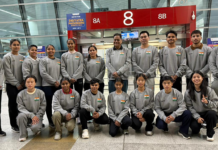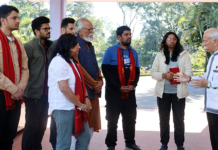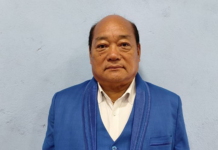[ Nani Halyi ]
The 1970s marked the beginning of the Green Revolution in India, transforming the country’s agricultural sector. Industrialization accelerated in the 1980s, and the late 1990s saw the IT boom, with the IT sector emerging as a key contributor to GDP. Each period in history has seen exponential growth in a particular area. Ensuring that we recognise the emerging trends and invest in booming sectors is crucial to drive the nation’s growth.
The India of 2020s is witnessing a paradigm shift towards becoming a sporting nation. The Indian sports industry registered an impressive 11% growth in 2023 alone. It is now valued at approximately ?15,766 crore (around $1.9 billion), a four-fold increase over the past decade. While cricket continued to dominate the industry with 87% market share in 2023, the emergence of non-cricket professional leagues like the Indian Super League (ISL), Pro Kabaddi League (PKL), and Pro Volleyball League has been an encouraging development.
The Govt. of India has reiterated its commitment to position India as a global sports leader as it considers sports as a crucial driver for development. With growing interest and increased efforts from both the government and private sectors, we appear to be on the brink of a “Sports Revolution” era in India. We’re witnessing the ‘Indian sports story’ unfold before our eyes.
India is slowly but gradually realising the potential of sports as a form soft power, capable of driving the nation’s growth and enhancing a region’s global appeal. Initiatives under the present dispensation like Fit India Movement and Khelo India highlight the government’s vision to promote sports as a means of national development, social inclusion and global recognition.
These efforts align with global practices where nations leverage sports to enhance their soft power and regional appeal, much like the U.S. and China.
Saudi Arabia is another country that, in recent years, has made significant efforts to establish itself as a global player in the sports arena, investing billions in a wide range of sports. While some view these efforts as an attempt at reputational laundering to rehabilitate Saudi Arabia’s global image, which has been marred by controversies around human rights and discrimination against women-a phenomenon often termed “sportswashing”-Saudi Arabia considers sports integral to its Vision 2030 strategy which aims to transition the country’s economy from oil dependency to a more diverse model.
In line with the Centre’s commitment to leverage the soft power of sports to propel India’s evolution into a global superpower and achieve the Vision of Viksit Bharat@47, efforts have been initiated in Arunachal Pradesh so as to capitalize on this momentum and take necessary steps to develop its sports ecosystem. It has been realized that investing in sports would not only produce skilled athletes who bring laurels to the state and nation but will also enhance the state’s brand and influence on the national stage.
In the recent times, the state govt. has taken a number of initiatives in the same direction. Arunachal Mission Olympics, a state initiative to produce Olympians, was launched by the CM Shri Pema Khandu on the National Sports Day. Construction of the Golden Jubilee Multipurpose Stadium in Yupia and the High Altitude Stadium in Tawang; the launch of 58 Khelo India Centres; and hosting national events like the 77th Santosh Trophy National Football Championship; all came as a positive development.
We all agree that the role of government in promoting sports is primary, but this takes us to a question- “Is it enough to accelerate the sports momentum?”
The government spending on sports, both at the central and state levels, remains extremely low. The Union Budget for sports in 2023-24 was around ?3,397.32 crore, accounting for less than 0.1% of India’s total budget allocation. This, along with the understanding that any sector will struggle without sufficient investment, underscores the need for private sector investment to fill the gap.
Corporate Social Responsibility (CSR) spending on sports and Public-Private Partnership (PPP) models could go a long way in the development of sports in the state. Corporate Social Responsibility (CSR) spending refers to the funds a company allocates to societal causes. Under the Companies Act of 2013, companies are legally required to spend at least 2% of their average net profits on CSR initiatives each year.
The Act of 2013 includes “training to promote rural sports, nationally recognised sports, Paralympic sports and Olympic sports” as activities that can be included by companies in their CSR ambit. The obligations under CSR were expanded in 2016 to include “construction, renovation, maintenance of stadiums, gymnasiums and sports science support including rehabilitation centers” as permissible CSR activities.
Public-Private Partnership (PPP) models, on the other hand, are collaborations between the government and private enterprises to deliver public services and assets.
The private sector can play a crucial role in accelerating the growth of sports. In leading sports nations, private companies have been instrumental in shaping robust sports ecosystems. The Bird’s Nest Stadium in China, the Australian Institute of Sport (AIS)-a high-performance sports training institution-and the Olympic Training Centers in the U.S. were all developed through PPP models. In Paris, the Olympic Village for the 2024 Olympics was funded publicly and by private companies, which will repurpose parts of the village for residential and commercial use, ensuring a lasting legacy for the city.
In India as well, companies are increasingly recognizing the importance and benefits of investing in sports, leading to a steady increase in CSR spending on the sector. Jindal Steel Works (JSW), Reliance Foundation, Tata Steel, IOCL, ONGC, and Hindustan Zinc actively contribute through sports sponsorships. These initiatives are a great way for companies to not just contribute to promotion of sports but also help in building a brand value that resonates with the aspirations of the common people.
The Sports Excellence Programme (SEP), launched by JSW Sports in 2012, scouts athletes with potential from across the country and provides them with financial support and training opportunities. As part of the Reliance Foundation Olympics Initiative, Reliance has partnered with the Indian Olympic Association (IOA) to support national sports federations and Indian athletes in major multi-sport events.
Athletes under these programs receive scholarships, sports science support, training under elite coaches and regular exposure to international tournaments.
Working with Odisha state government on a PPP model, Reliance has built the Odisha-Reliance Foundation Athletics High-Performance Centre (HPC) in Bhubaneswar. High-Performance Sports Training and Rehabilitation Centers in Guwahati and Jorhat was constructed by Assam government in partnership with Abhinav Bindra Foundation, Oil India Ltd., and Numaligarh Refinery Ltd. These HPCs play a crucial role in the development of elite athletes, providing them with state-of-the-art facilities, advanced training programs, and access to sports science and medical support.
Several state governments are integrating Public-Private Partnerships (PPPs) into their sports development initiatives. States like Uttar Pradesh, Odisha and Gujarat have incorporated PPP models into their sports policies for infrastructure projects like constructing sports stadiums and academies. These partnerships facilitate quicker and more efficient project completion, as private developers bring the necessary funding and technical expertise.
Even in the absence of committed institutional support and training facilities, the athletes of Arunachal have repeatedly proved that there is no lack of sporting talent in the state. Athletes like Rupa Bayor (India’s first Taekwondo athlete to break into the top 10 of the World Poomsae Rankings), Gyammar Nikum (named the most valuable Under-21 football player for the 2024-25 session), Yukar Sibi (a Commonwealth medalist in weightlifting), are just some names that have made the state proud with their exemplary achievements.
The fact remains, however, that the talents of many potential stars could not be exploited because of inadequate support systems. We wish that the programs like the Sports Excellence Program (JSW sponsored), and the Reliance Foundation Olympic Initiative are initiated in the state along with the government-supported schemes. The establishment of various High-Performance Centres can provide crucial support, offering much-needed training facilities, sports science assistance, and expert coaching for our athletes. Such initiatives play a vital role in nurturing talent and bridging the gap between potential and performance, helping athletes compete at the highest levels.
The last decade saw the rise of some prominent private companies based in our state including the likes of Puna Hinda Constructions, Nigla Group of Automobile & Construction Industries, Kenge Constructions and Naara Aaba, etc. These companies have been involved in many philanthropic works besides contributing to the growth of the state’s economy.
Public sector companies like NHPC and NEEPO, known by their commitment to be a socially responsible corporate entity and contribute to improve the lives of people and society at large, are actively engaged in different projects across the state.
Such private entities, as part of their CSR spending, can significantly contribute to societal development by investing in sports. Such contributions can not only provide budding athletes with opportunities to excel on prominent platforms but also serve as a gateway to better lives for them. Moreover, sports can play a pivotal role in addressing societal challenges such as drug abuse and excessive screen time, both of which lead to chronic health issues and the deterioration of lives.
A thriving sporting culture can engage youth in productive physical activities, channeling their energy into sports and away from these harmful habits. This fosters not only individual well-being but also community cohesion, promoting a healthier, more vibrant society.
With the right support and collaboration from both government and the private sector, our state can produce top athletes for the country, solidify its place as a region of national influence, attract investments, develop tourism, and drive socio-economic progress-all of which will contribute significantly to the state’s economic development.
Beyond developing the sports ecosystem, sports investment also offers private entities involved an opportunity to enhance brand visibility, foster community development, and build goodwill- a win-win situation for everyone.
This article is a call to all stakeholders-particularly corporations and high-net-worth individuals with the resources and commitment to community development-to leverage the power of sports as a tool for positive change. (Nani Halyi is Technical Coordinator, Arunachal Pradesh Football Association)




